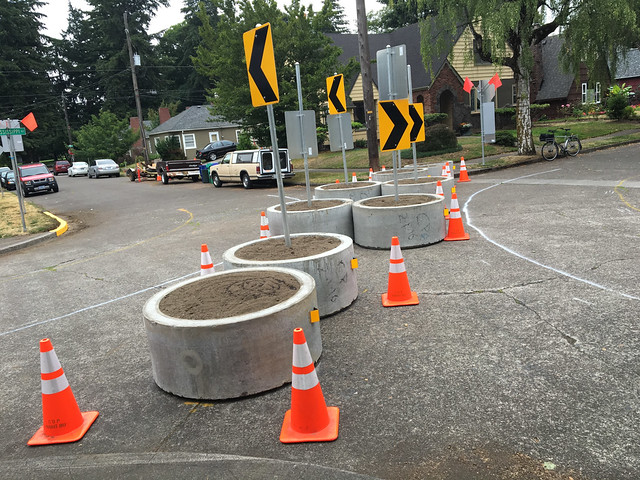With two new traffic diverters installed in the past week, the City of Portland continues to fulfill its promise to defend the low-stress biking environment on neighborhood greenways.
People who ride or live near North Mississippi and Holman and Southeast Ankeny and 15th should notice fewer cars and lower speeds in their neighborhoods. That’s because of 8-10 large concrete drums filled with soil that are now spread diagonally across those intersections. The idea is to discourage people from driving on neighborhood streets that have been set aside as bike routes.
The new diverters also illustrate how the Bureau of Transportation is now able to move faster on small projects thanks to recent staffing and policy changes (a strong push from grassroots activists at BikeLoudPDX also played a key role). As we reported back in March, PBOT has a new engineer on staff to oversee projects with small budgets. These diverters cost around $5,000, an amount that would struggle for attention alongside much larger projects in PBOT’s capital projects program. With a new staffer these projects can move forward without a stop at the capital projects desk.
Here’s a closer look at the two new diverters…
Holman diverter a secondary measure

The new diverter on North Holman and Mississippi isn’t on a neighborhood greenway; but it wouldn’t exist without one. It comes in response to people who were avoiding the North Michigan Neighborhood Greenway because of a diverter installed a few blocks away (on Rosa Parks and Michigan) in 2013. Too many people were driving north on Michigan (to avoid backups on Interstate 5) and then cutting over to Mississippi one block east to avoid the diverter at Rosa Parks. People who live on that one block of Mississippi weren’t happy.
This new diverter will now force people going east on Holman to turn south (right) onto Mississippi and go back to to Ainsworth. The large concrete drums will keep car users from passing through the intersection east-to-west and north-to-south. If all goes according to plan, people who use Michigan during the evening rush as a way to avoid traffic on Interstate 5 will decide it’s just not worth the hassle.
One issue of note is that the current design doesn’t make it easy for bicycle users to pass through the median in any direction. PBOT needs to adjust the spacing of the concrete drums so that people can easily bicycle through. They’ve done a much better job at this over on Ankeny…
Advertisement
Ankeny diverter should tame traffic in growing neighborhood
Inner Ankeny is very busy these days. And not just with cars and bikes. The area is booming with new housing and related commercial development in what could be a poster-child street for Portland’s growing pains.
The cycling situation on Ankeny is similar to that of SE Clinton Street. Both are legacy neighborhood greenways (built as “bicycle boulevards” in the late 1990s) and both are adjacent to quickly-growing commercial corridors (Burnside and Division respectively). PBOT identified six of these older greenways in their 2015 Neighborhood Greenways Assessment Report. Clinton was first on the list for improvements and now it’s Ankeny’s turn. This new diverter is one of many changes coming to the street meant to bring it up to par with current standards.
The Ankeny/15th diverter is very similar to the one on Holman and Mississippi. Large, soil-filled concrete drums are aligned diagonally from the northwest corner to the southeast corner of the intersection. Unlike the Holman diverter, PBOT has made this one much easier for people to bike through. In addition to leaving an opening in the median they’ve also laid down pavement markings to make it obvious where you are expected to ride. While observing it this morning I noticed the opening was wide enough for a standard, two-seater bicycle trailer.

This new diverter should help reduce auto use on Ankeny in both directions. This is great news because Ankeny is one of the most heavily-used bikeways in the city. In some stretches (near SE 28th), the street has more bike trips than car trips.
Another thing that comes with these diverters is a parking restriction on the northeast and southwest corners of the intersections. This was done to aid the auto turning movements, but it will also improve visibility for everyone who uses the sidewalk and street.
And a note of caution for all users of these intersections. People approaching from the east and west do not have stop signs — that goes for bicycle riders and auto drivers. And if you are driving or riding north-south, remember that bicycle riders coming from east and west are not required to stop.
CORRECTION: This article originally stated that each diverter costs around $50,000. That is incorrect. They cost $5,000. Sorry for any confusion.
— Jonathan Maus, (503) 706-8804 – jonathan@bikeportland.org
Our work is supported by subscribers. Please become one today.









